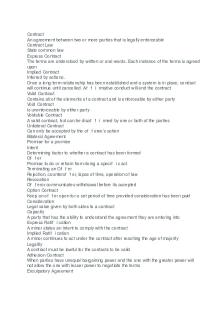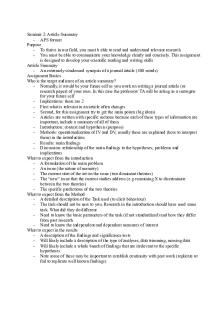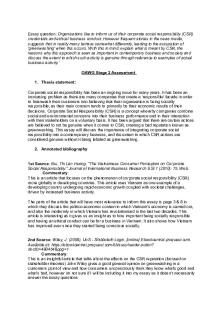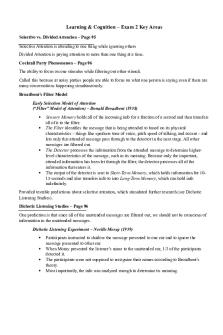Mast200 2 - Lecture notes 2 PDF

| Title | Mast200 2 - Lecture notes 2 |
|---|---|
| Course | the oceans |
| Institution | University of Delaware |
| Pages | 3 |
| File Size | 46.3 KB |
| File Type | |
| Total Downloads | 34 |
| Total Views | 165 |
Summary
lecture notes...
Description
why ice floats - Ice floats in water because all of the molecules in ice are held in hexagons and the center of the hexagon is open space, making ice 8% less dense than water major cations - Na+, Mg2+, Ca2+, K+ major anions - Cl-, SO4 2conservative property - The major constituents of salinity display little variation over time non-conservative property - Concentrations of nutrients vary greatly over time 3.5% - what is the salinity of the ocean water cold and salty - most dense water how salt water is formed - when all carbonate has been converted to oxide, all bromine and iodine has been replaced by chlorine and all organic compounds have been oxidized at a temperature of 480oC chorine - used to determine the total amount of salt presence decreases - as density increases, temperature _______________ increases - as density increases, salinity _________________ increases - as density increases, pressure ________________ chlorinity - is the amount of halogens (chlorinity, bromine, iodine, and fluorine) in the seawater and is expressed as grams/kilogram or o/oo solubility in gases - increase in pressure decreased in temperature decrease in salinity thermocline - sharp, temp gradient surface layer - -100 m deep -2% of the ocean -least dense -receives sun and precipitation pycnocline layer - -18% of ocean -non at high latitude deep layer - -80% of ocean -bulk originates at high latitude -cold < 4 degrees Celsius haloclines - thermocline at mid latitudes low high low - salinity from high to low latitudes higher - in warmer shallower waters the ph is ____________ lower - in colder deeper waters the ph is _________ How is CO2 related to the buffering capacity of seawater? - The CO2 system prevents large fluctuations in pH in the ocean and a stable pH is required for organisms to sustain life. dissolved oxygen - in colder fresher water, there is more ________________ Hadley cell - -from equator to 30 degrees latitude -warm moist air expands becomes less dense forming a zone of low pressure called
doldrum doldrum - low pressure zone formed from warm moist air becoming less dense horse latitude - at high altitude the air flows poleward, becomes cooler and denser, until it sinks Earth's surface at about 30 degree, forming a high pressure zone -low rainfall polar front - less dense warm air is forced up over denser cold air ferrel cell - from 30 degrees to 50 degrees warm moist air - the least dense form of air is increase - high pressure makes the density of the air ________________ p= pgh - atmospheric pressure formula faster winds - higher pressure gradient force low - ocean experiences __________________ pressure high - land experiences _________________ pressure right - coriolis deflection: northern hemisphere moves the the ____________ left - southern hemisphere moves to the ___________ heat capacity - A direct result of the hydrogen bond in water is the high heat capacity of water. Of water compared to that of most other substances is great. latent heat - the heat required to change a phase the direction the come in - wind and currents named by 1. Understand the two types of oceanic circulation, and how surface and deep ocean currents are formed, and how sea surface circulation patterns compare with deep-water circulation patterns. - - Two types are: surface ocean currents and deep ocean currents - Surface currents are 10% of ocean water and are driven by wind and wind friction, reflect global wind patterns and coriolis effect, primarily horizontal motion, transfer heat from warmer to cooler areas (Moves faster than deep sea currents) - Deep ocean currents are driven by density which is created by differences in temperature and salinity, horizontal and vertical motion, provides oxygen to deep sea 2. What is a gyre? What drives oceanic circulation in forming gyres? - - Gyres are large circular moving loops of water, zonal winds drives the oceanic circulation that forms them a. Wind, friction, Coriolis - NE trade winds drives westward flow, westerlies drive eastward flow. Coriolis deflection deflects down gradient flow of water, each successive layer moves increasingly to the right. b. What is the Ekman Spiral? What is Ekman Transport? - Ekman spiral describes speed and direction of water flow at different depths. So in Ekman transport, the surface water is moved 45 degrees to the right while the net transport of the water column is 90 degrees (towards which wind is blowing) c. How do continents and pressure gradient forces influence gyre formation? continents drive westward flow to north and eastward flow to the south. Pressure
gradients - sea surface is high where pressure is high so there is a gradient where water wants to move from high to low (water wants to move down - pressure gradient force). d. What is geostrophic flow? Describe the flow around an ocean gyre. - surface circulation is called geostrophic flow, where pressure gradient force is balanced by coriolis force and the flow is parallel to isobars. Water flowing outward from center of gyre exactly balances water flowing inward AND downhill pressure gradient force exactly balances with uphill coriolis force. (geostrophically balanced gyres flow clockwise) 3. What is western intensification? - - Western boundary of all oceans has steep gradient in sea surface height so there is an intensified pressure gradient force on western boundaries, currents are narrow, deep and strong. Example: Gulf stream. 4. Where is the Gulf Stream? How do cold core rings form there, and why are they important to oceanic production? - northward accelerating current offshore of east coast of north America, narrow, deep and fast until it moves offshore at cape Hatteras. Cold core rings enclose cold water south of the gulf stream path where meanders break free. Cold core rings bring nutrient rich water to Sargasso sea. 5. How does coastal upwelling and downwelling occur? Why is this important to oceanic production? - - Along coastal areas, Eckman transport can induce: -downwelling by driving water towards the coast, or -upwelling by driving water away from the coast *Important because something has to replace the water that is being moved by these currents and it is a huge source of nutrients for sea life What is Langmuir circulation? - a complex horizontal helical (spiral) motion that extends parallel to the wind Thermohaline circulation and the importance of large scale circulation! - definition: ocean circulation driven by density characteristics of respective oceanic water masses. (as density decreases, temperature increases and salinity decreases). 8. What are the 4 different types of water masses, in addition to surface waters? intermediate water mass, deep water mass, and bottom water mass, (also hybrid water mass) How can oceanic circulation be described as the ocean "conveyer belt"? - The major thermohaline currents appear to flow mainly toward the equator. - they originate in the polar regions - their outward flow is confined between the continents...
Similar Free PDFs

Mast200 2 - Lecture notes 2
- 3 Pages

2 - Lecture notes 2
- 5 Pages

Lecture notes, lecture 2
- 3 Pages

2 Biodiversity - Lecture notes 2
- 33 Pages

Chapter 2 - Lecture notes 2
- 30 Pages

Blaw 2 - Lecture notes 2
- 4 Pages

Chapter 2 - Lecture notes 2
- 4 Pages

Seminar 2 - Lecture notes 2
- 2 Pages

Stage 2 - Lecture notes 2
- 3 Pages

Micro 2 - Lecture notes 2
- 18 Pages

2 Sources - Lecture notes 2
- 4 Pages

Prof 2 - Lecture notes 2
- 3 Pages

Quiz-2 - Lecture notes 2
- 7 Pages

Chapter 2 - Lecture notes 2
- 11 Pages

Chapter 2 - Lecture notes 2
- 4 Pages

Exam 2 - Lecture notes 2
- 5 Pages
Popular Institutions
- Tinajero National High School - Annex
- Politeknik Caltex Riau
- Yokohama City University
- SGT University
- University of Al-Qadisiyah
- Divine Word College of Vigan
- Techniek College Rotterdam
- Universidade de Santiago
- Universiti Teknologi MARA Cawangan Johor Kampus Pasir Gudang
- Poltekkes Kemenkes Yogyakarta
- Baguio City National High School
- Colegio san marcos
- preparatoria uno
- Centro de Bachillerato Tecnológico Industrial y de Servicios No. 107
- Dalian Maritime University
- Quang Trung Secondary School
- Colegio Tecnológico en Informática
- Corporación Regional de Educación Superior
- Grupo CEDVA
- Dar Al Uloom University
- Centro de Estudios Preuniversitarios de la Universidad Nacional de Ingeniería
- 上智大学
- Aakash International School, Nuna Majara
- San Felipe Neri Catholic School
- Kang Chiao International School - New Taipei City
- Misamis Occidental National High School
- Institución Educativa Escuela Normal Juan Ladrilleros
- Kolehiyo ng Pantukan
- Batanes State College
- Instituto Continental
- Sekolah Menengah Kejuruan Kesehatan Kaltara (Tarakan)
- Colegio de La Inmaculada Concepcion - Cebu